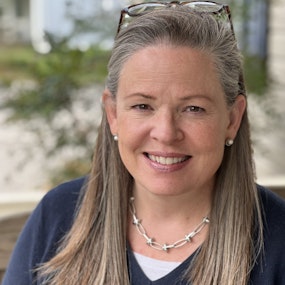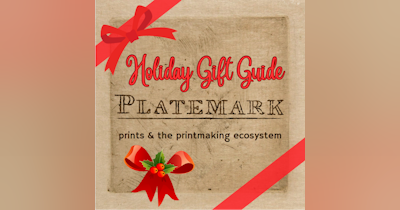In s3e24, I speak with Steve Goddard, curator and professor (retired) from the Spencer Museum of Art at the University of Kansas in Lawrence. Sounds simple enough, right? Talk, record it, export it into the right format, and presto. Well, there's a bit more to it than that. Read on to get a behind-the-scenes glimpse at the making of a Platemark episode.
First, one needs to convince a guest that the episode is worth doing and that it's much easier than they imagine. After a bit of "are you sure you want me," Steve was game. Recording is really the easiest part as long as the technical connection works properly. It seems like every time I record with someone (I gave up on Zencastr and am using Riverside), either my guest or I can't hear the other. Solution: exit the program and come back into the recording "studio." Then, we talk for about an hour and a half, after which the guest is off the hook.
Then the work really starts. I produce the episode in video format so viewers can see the two of us talking. I also intersperse any prints we've talked about. Once the video version is set, I also export an audio version, which goes to Apple, Spotify, etc.
Getting to done takes a few steps and a lot of time. I'm no expert at audio and video anything, so I send the two recorded tracks (one of me and one of Steve) along with the intro and outro to my sound guy, Dan Fury, Extension Audio. He's in Portland, OR, but no matter. The splendors of the interwebs. (Thanks to Martha Lucius for connecting me to Dan.) After Dan works his magic and sends the video file back to me, I give it a first listen. At this point I'm editing out egregious uses of like, so, and um, while taking note of all the prints we talk about. Armed with the list of artworks discussed, I go in search on the world wide web for the images and their caption information.
Not all images are created equal, so if the first image I find has crappy resolution, I look for another version (the beauty of multiple impressions of prints!). I heavily rely on the collection database of the Metropolitan Museum of Art for Old Master prints because they have invested in great images of their works and share them freely. (Huge thanks to them!) Once I save the images, I grab the caption information. This all needs to be formatted since every collection lists things in different orders, etc. I keep a single Word document of all the captions since some get reused over and over and it's easier to search a single document for that info. Seems simple enough, but some episodes include twenty plus images. It's not hard; it just takes time.
Once I have collected all the images and captions, I build a Power Point presentation--one slide per work of art. The document is saved so that each slide is an individual jpeg. These jpegs of PPT slides are what I pull into the video editor (Descript) in the appropriate places so viewers can follow along easily. As I'm placing the visuals, I'm editing more, as well as correcting the transciption: prints = prince.
Once the main body of the episode is finished, it's exported as a video (MP4). I send this file to the interviewee for approval. It's a huge file (Steve's video is 12GB) so I use WeTransfer to send it. This is Steve's opportunity to say, you know, at 5:32 I said something about XYZ, can we take it out. I'm always happy to make those last edits. No one should be unhappy with their episode. Once everything is set and the MP4 is resaved, it is exported as an MP3 (audio only).
The MP3 version is loaded up to an episode aggregator called Libsyn. When the release date comes, Libsyn sends it out to Apple podcasts, Spotify, Google podcasts, Pocket Casts, and whoever else you designate. The MP4 (video) is loaded up to the Platemark YouTube channel.
Now, the video has the images of works of art built into it. The MP3 does not. So, over on the podcast website (I use PodPage), I build the shownotes. Following a general introduction to the episode, I list each image and its caption in the order it is talked about so listeners can follow along. For whatever reason, on PodPage the shownotes can't be flushed out until after the episode goes live. This used to mean I'd get up at 6:00 and add all the images one by one to the text block and publish it as soon as I could. Kinda a hamster wheel. But I recently discovered a workaround. I can complete the shownotes in a draft blog post, then can cut and paste the whole thing into the shownotes section the morning of the release. This is a huge change for me and I'm grateful to have found it.
So we have the YouTube video going live this morning at 5:00 am. The audio version is sent to all the various plateforms at 5:00 am, too. We're done, right? Wrong. I still need to post to Facebook, Instagram, Linked In, and get an email blast out. Before I found Mailer Lite, I used to write and send an email to various people on release morning. Now I've gone legit and send an email blast through Mailer Lite. This email can be drafted ahead of time and be scheduled to be sent on release morning--I set it for 7:00 am. This is a huge help. And I think it looks a bit more professional.
Then I go over to Facebook and create a post that includes a selection of images from the episode. I post through my personal account and the Platemark page. Then I share the post into a variety of print-interested groups. I do the same on Instagram posting to my personal account and the Platemark account. Lastly, I create a post on Linked In.
Conventional wisdom says one should write a blog post for every episode, but I haven't got that one down yet. But for some reason I thought I'd share this behind-the-scenes info with you. I love making Platemark, but it's a lot of work, and I'm a virtually one-person band. Next time you listen to The Daily or some other big-time podcast, listen at the end to how many people staff it! I counted 21 people on an episode of something recently. If only.
I hope you are loving Platemark. Please tell a friend, leave a review, and support us in whatever way you are able. I really appreicate it.


